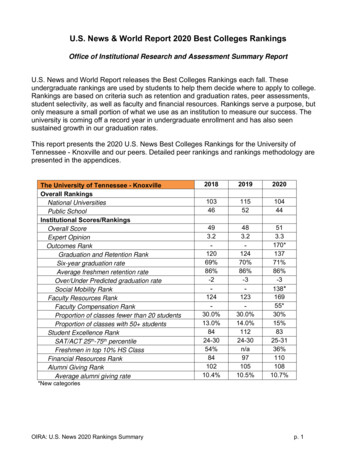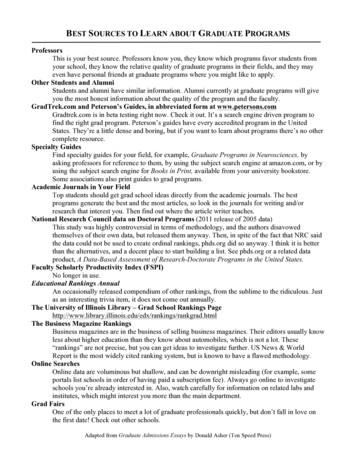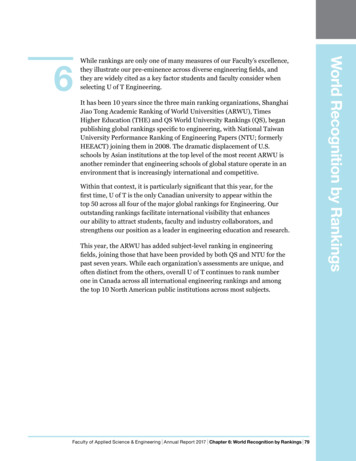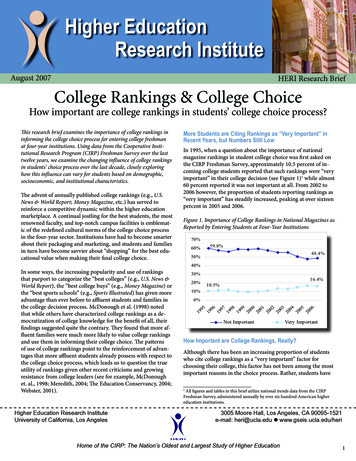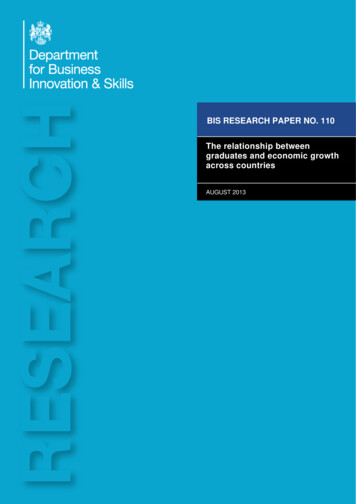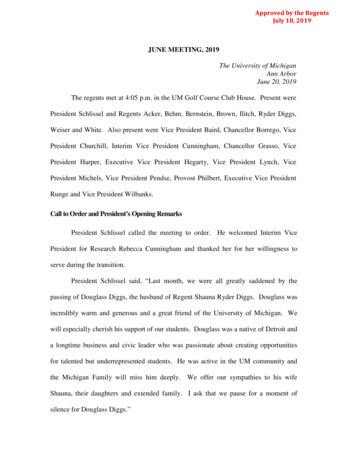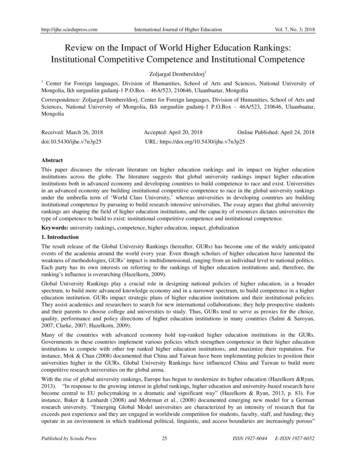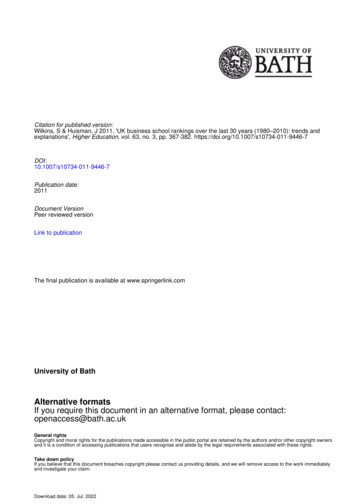
Transcription
College RankingsHistory, Criticism and ReformLuke Myers and Jonathan RobeCenter for College Affordability and ProductivityA Report from theCenter for College Affordability and ProductivityMarch 2009
College Rankings: History Criticisms and ReformAbout the AuthorsLuke Myers is a senior studying political science through the Honors Tutorial College at Ohio University. He is currently writing an undergraduate thesis on deliberative democracy and has been a research assistant with CCAP since June 2008.Jonathan Robe has been a research assistant at CCAP since August 2007. He is anundergraduate student at Ohio University majoring in mechanical engineering andcurrently serves as an Engineering Ambassador for the college.About the Center for College Affordability and ProductivityThe Center for College Affordability and Productivity is a nonprofit research centerbased in Washington, DC, that is dedicated to research on the issues of rising costsand stagnant efficiency in higher education.1150 17th ST. NW #910 202-375-7831 (Phone)Washington, DC 20036 202-375-7821 egeaffordability.blogspot.com2
Luke Myers and Jonathan RobeTable of ContentsIntroduction . 5The History of Academic Quality Rankings . 5Contributions and Criticisms of College Rankings . 22Effects of College Rankings . 28College Rankings Reform . 31Conclusion . 38Figures and TablesTable 1: Correlations Between American MBA Rankings . 24Figure 1: Correlation Between USNWR Ranks withPrevious Year’s Ranks (National Universities) . 31Figure 2:Correlation Between USNWR Ranks withPrevious Year’s Ranks (Liberal Arts Colleges) . 31Table 2: Correlations of Component Ranks to Overall Rank inU.S. News (National Universities) . 32Table 3: Correlations of Component Ranks to Overall Rank inU.S. News (Liberal Arts Colleges) . 32Table 4: Dependent Variable is the Ranking Score,Ordinary Least Squares Estimation . 38Table 5: Dependent Variable is the Ranking Score,Ordinary Least Squares Estimation . 39Table 6: Dependent Variable is the Ranking Score,Ordinary Least Squares Estimation . 403
College Rankings: History Criticisms and Reform4
Luke Myers and Jonathan RobeIntroductionToday, college quality rankings in news magazines and guidebooks are a big business with tangible impacts on the operation of higher education institutions. Thecollege rankings published annually by U.S. News and World Report (U.S. News) areso influential that Don Hossler of Indiana University derisively claims that highereducation is the victim of “management” by the magazine. There is certainly supportfor such a claim: college rankings—particularly those of U.S. News—sell millions ofcopies when published, affect the admissions outcomes and pricing of colleges, andinfluence the matriculation decisions of high school students throughout the world.1How did academic quality rankings of colleges and universities become so powerfulin higher education? A review of their historical development in the first section ofthis study may surprise many readers. While college professors and administratorsalike largely decry rankings today, their origin lies in academia itself. Begun as esoteric studies by lone professors, college rankings’ development into the most popularly accepted assessment of academic quality was fueled by the very institutions ofhigher education they now judge. While the purpose and design of academic qualityrankings has evolved during the century since their creation, their history teachesone clear lesson: college rankings fill a strong consumer demand for informationabout institutional quality, and as such, are here to stay for the foreseeable future.Various approaches to college rankings have different benefits and each is subject tolegitimate criticism, all of which should be seriously considered in light of the powerful effects that a widely-distributed ranking can have on institutions of higher education and the students seeking to enter them. Sections II and III will explore theseaspects of college rankings, respectively. In light of the historical lessons revealed inSection I, however, movements that seek to reform college rankings should be focused on producing better rankings, rather than on trying to eliminate or ignorethem. Section IV will survey multiple new indicators of academic quality that manyview as potential improvements over the indicators upon which current college rankings are based.The History of Academic Quality RankingMany and various efforts have been made to assess the quality of higher educationinstitutions. Accreditation agencies, guidebooks, stratification systems, and rankings all have something to say about the quality of a college or university but express it in very different ways. For clarity, we will adopt higher education researcher5
College Rankings: History Criticisms and ReformDavid Webster’s definition of “academic quality rankings.” For Webster, an academicquality ranking system has two components:1. It must be arranged according to some criterion or set of criteriawhich the compiler(s) of the list believed measured or reflected academic quality.2. It must be a list of the best colleges, universities, or departmentsin a field of study, in numerical order according to their supposedquality, with each school or department having its own individualrank, not just lumped together with other schools into a handful ofquality classes, groups, or levels.2All but one of the studies and publications discussed below will fit both criteria andso will qualify as “academic quality rankings.”Ranking systems that meet these two criteria can be further distinguished by theirplacement within three polarities. First, some rankings compare individual departments, such as sociology or business, within a college or university, while othersmeasure the quality of the institutions as a whole, without making special note ofstrong or weak areas of concentration. Second, rankings differ by whether they rankthe quality of graduate or undergraduate education. The judging of graduate programs and comparing of individual departments are often coupled together in aranking system. This should come as little surprise considering the specialization ofgraduate-level education. Similarly, ranking undergraduate education usually, butnot always, involves ranking whole institutions, probably due to the fact that a wellrounded education is often viewed as desirable at this level.More important than what rankings judge is how they do the judging. Most academic quality rankings to this point have used one of two primary strategies for determining quality: outcomes-based assessment or reputational surveys, althoughother objective input and output data such as financial resources, incoming studenttest scores, graduation rates, and so forth have often been used to supplement theseprimary measures. Rankings that look at college outcomes are often concerned withapproximating the “value-added” of a college or university. They use data about students’ post-graduate success, however defined, to determine the quality of highereducation institutions and have often relied on reference works about eminent persons such as Who’s Who in America. Reputational rankings are those which are significantly based on surveys distributed to raters who are asked to list the top departments or institutions in their field or peer group.6
Luke Myers and Jonathan RobeEither form of academic quality rankings—outcomes-based or reputational—can beused in departmental or institutional rankings and graduate or undergraduate rankings. In fact, there have been two major periods in which each method of rankingwas ascendant: outcomes-based rankings, derived from studies of eminent graduates, were published in great number from 1910 to the 1950s, while reputationalrankings became the norm starting in 1958 and continuing to the present.3 Whilethere has been some renewed interest in outcomes-based rankings recently, theyhave yet to regain parity with reputational rankings in terms of popularity. The restof this section will examine a number of major academic quality rankings throughout history, and explore their development from esoteric studies into one of the mostpowerful forces in higher education.Early Outcomes-Based RankingsThe first college rankings developed in the United States out of a European preoccupation—especially in England, France, and Germany—with the origins of eminentmembers of society. European psychologists studied where eminent people had beenborn, raised up, and attended school in an attempt to solve the question of whethergreat men were the product of their environment (especially their university) or weresimply predestined to greatness by their own heredity. In 1900, Alick Maclean, anEnglishman, published the first academic origins study entitled Where We Get OurBest Men. Although he studied other characteristics of the men, such as nationality,birthplace, and family, at the end of the book he published a list of universitiesranked in order by the absolute number of eminent men who had attended them. In1904, another Englishman, Havelock Ellis—a hereditarian in the ongoing natureversus nurture debate—compiled a list of universities in the order of how many“geniuses” had attended them.4In each case, neither author explicitly suggested the use of such rankings as a toolfor the measurement of the universities’ quality. Although there seems to be an implicit quality judgment in simply ranking universities according to their number ofeminent alumni, the European authors never made the determination of academicquality an explicit goal. However, when Americans began producing their rankingswith this very aim, they used similar methodologies and data. Many of the earliestacademic quality rankings in the United States used undergraduate origins, doctoralorigins, and current affiliation of eminent American men in order to judge thestrengths of universities.5The first of these rankings was published by James McKeen Cattell, a distinguishedpsychologist who had long had an interest in the study of eminent men. In 1906, hepublished American Men of Science: A Biographical Dictionary, a compilation of short7
College Rankings: History Criticisms and Reformbiographies of four thousand men that Cattell considered to be accomplished scientists, including where they had earned their degrees, what honors they had earned,and where they had been employed. He “starred” the thousand most distinguishedmen with an asterisk next to their biography. In the 1910 edition of American Men ofScience, Cattell updated the “starred” scientists and aggregated the data aboutwhich institutions these men had attended and where they taught at the time, givinggreater weight to the most eminent than to the least. He then listed the data in a table with the colleges in order of the ratio of this weighted score to their total numberof faculty, thereby creating the first published academic quality ranking of Americanuniversities.6Cattell understood that he was making a judgment about these institutions’ qualityas evidenced by his titling the table “Scientific Strength of the Leading Institutions,”and his claim that “[t]hese figures represent with tolerable accuracy the strength ofeach institution.” Cattell was also aware that prospective students would be interested in the judgments of quality. He wrote, “Students should certainly use every effort to attend institutions having large proportions of men of distinction among theirinstructors.” Furthermore, Cattell claimed that the “figures on the table appear to besignificant and important, and it would be well if they could be brought to the attention of those responsible for the conduct of the institutions,” implying a belief thatthe rankings represented a judgment of quality that could be improved over time ifthe institutions took the correct actions.7Although Cattell’s first study was not based purely on the measured outcomes of theinstitutions he ranked, it was central to the development of later outcomes-basedrankings. Cattell himself would continue to publish similar studies in which hejudged institutions of higher education based on the number of different eminentpeople—not just scientists—they both produced and employed, without ever fundamentally altering his methodology. From Cattell’s 1910 study until the early 1960s,the quality of institutions of higher education would be most frequently judged usingthis method of tracking the educational background of distinguished persons.8One researcher who was greatly influenced by Cattell’s work, but who even more explicitly dealt with the quality of academic programs, was a geographer from IndianaUniversity named Stephen Visher. Interested in why geographical areas demonstrated a disparity in the number of scientific “notables” they produced, Visherlooked at the undergraduate education of the 327 youngest “starred” scientists inCattell’s 1921 edition of American Men of Science. Such an approach tested the hypothesis that the disparities resulted because “the leaders come from those who aregreatly stimulated in colleges.” He ranked the top seventeen institutions by the ratioof the young “starred” scientists to total student enrollment, thereby creating the8
Luke Myers and Jonathan Robefirst enrollment-adjusted outcomes-based ranking. Visher suggested that the rankdemonstrated the “comparative success of these institutions in inspiring undergraduate students,” and argued that “[t]he conspicuous contrasts in the numberand percentage of graduates who later become leaders suggest that there aremarked variations in the stimulating value of institutions.”9Beverly Waugh Kunkel, a biologist at Lafayette College, and his co-author Donald B.Prentice, then president of the Rose-Hulman Institute of Technology, repeatedlyused a methodology similar to that of Cattell and Visher, but stated their interest inthe academic quality of universities even more explicitly. In their first study, published in 1930, Prentice and Kunkel expressed interest in “what elements constitutea successful institution,” especially in light of the large investments that individualswere making in their educations. The authors believed that “undoubtedly the mostreliable measure” of a higher education institution was “the quality of product.”Therefore, Prentice and Kunkel measured academic quality by the number of a college’s undergraduate alumni listed in Who’s Who in America.10Kunkel and Prentice repeated essentially the same methodology in periodical studiesfrom 1930 to 1951. They ranked schools according to the number of baccalaureateearning alumni who were listed in Who’s Who.11 In the 1930 study, the authors provided a table ranking the schools by absolute number of graduates listed and a second table ranking them according to the percentage of a school’s living alumni whowere listed. The authors noted that an overrepresentation of ministers and collegeprofessors and an underrepresentation of engineers in Who’s Who likely skewed theresults of their rankings. In the 1951 study, the authors listed the schools alphabetically with the absolute number of alumni listings and their numerical rank. Thislater study did not include a percentage based ranking, but instead focused on thetime period from which the listed alumni graduated, hoping that this might be ofuse in identifying good practices for those familiar with an institution’s historical operations.12One final early study that deserves mention is the first and last attempt by the federal government to explicitly compare academic quality among institutions. In 1910,the American Association of Universities (AAU) asked Kendric Charles Babcock,Higher Education specialist in the Bureau of Education, to publish a study of theundergraduate training at colleges so that graduate schools would be able to knowwhich applicants were best prepared. The Bureau of Education was chosen becauseit was believed by AAU that the rankings would be more widely accepted if they werecompiled by an impartial source without a connection to a university.9
College Rankings: History Criticisms and ReformBabcock’s study was a stratification and not a ranking. When finished, he divided344 institutions into four different classes rather than supplying an individual rankto each school. As with most of the early studies mentioned above, Babcock measured quality based on the outcomes an institution produced—here, the performanceof schools’ graduates after they entered graduate school—but he was not greatly influence by Cattell’s quantitative, eminent person methodology.13 On visits to severalgraduate schools, Babcock “conferred with deans, presidents, and committees ongraduate study,” and “inspected the credentials and records of several thousands ofgraduate students in order to ascertain how such students stood the test of transplanting.”14The accidental release of a draft of the study to the newspapers resulted in such afuror from the deans and presidents of colleges classified lower in the rankings thatPresident Taft issued an executive order prohibiting the study’s official release. TheCommissioner of Education, P.P. Claxton, tried to soothe the disgruntled by admitting that the classification was “imperfect” because its single criterion of graduateschool performance failed to account for the fact that many colleges may performvery highly in their provision of services to those students who do not go on tograduate school. Neither Claxton’s explanations nor the praise the classification received from some deans and presidents (mostly from class I schools), were enough toconvince President Wilson from rescinding Taft’s order when asked to do so by AAUupon his arrival in the White House.15 This historic episode demonstrates one reason why the federal government has never attempted to rank or in any way judgethe comparative academic quality of higher education institutions since.The Rise of Reputational RankingsReputational surveys would become the predominant method for producing academic quality rankings beginning in 1959, with the most popular ranking today, oneby U.S. News and World Report, containing a strong component of reputationalevaluation. However, this methodology was developed much earlier, in 1924, by Raymond Hughes, a chemistry professor at Miami University in Ohio. When asked bythe North Central Association of Schools and Colleges to complete a study aboutgraduate school quality, Hughes would turn to the opinion of his fellow faculty instead of relying on the then popular outcome-based methodology.16Hughes circulated two requests to Miami University faculty in twenty fields ofstudy—nineteen liberal arts disciplines and the professional discipline of education.The first sought from each faculty member a list of forty to sixty instructors whotaught their discipline in American colleges and universities. The second requestasked the recipients to rate, on a scale of one to five, the departments of thirty-six10
Luke Myers and Jonathan Robeinstitutions that offered a degree in their discipline, so as to create “a list of the universities which conceivably might be doing high grade work leading to a doctor’s degree.”17Hughes received about a 50 percent response rate. After weighting the ratings,Hughes produced a table that listed the departments according to how many 1, 2, 3,4 or 5 ratings they had received. Although he did not calculate an overall score foreach department, the ordered list, based on a specific criterion, meets the definitionof an academic quality rating, the first such list determined by a department’s reputation among selected raters. Hughes also did not aggregate the ranks of the departments to form an institution-wide ranking.During his chairmanship of the American Council on Education, Hughes wouldpublish another study in 1934 on graduate school quality of much wider scope.Hughes’s second study was an improvement over the first in many respects. First,the 1934 study covered thirty-five disciplines as opposed to the twenty disciplines inhis earlier study. The second study also gathered opinions from a more diverse fieldof respondents; to compile his list of raters, Hughes asked the secretary of each discipline’s national society for a list of one hundred scholars that would fully representthe field and its sub-fields, resulting in a greater number of respondents for eachdiscipline. However, while the 1934 study helped to refine the reputational methodology, it was not a ranking. Instead of listing the departments in order of their rating, Hughes simply listed alphabetically any department that at least half of the raters had judged as adequate.18Though developed during the same period as other outcomes-based rankings, thereputational methodology of judging academic quality was largely absent for twentyfive years after Hughes’s 1934 study. It would reappear in the appendix of GraduateStudy and Research in the Arts and Sciences at the University of Pennsylvania, published by a humanities professor, Hayward Keniston. The ranking was compiled inconnection with work he was doing for the University of Pennsylvania in 1959 tohelp compare it to other American research universities. Although Keniston’s ranking did not gather much attention beyond the walls of his institution, its publicationnonetheless marks the beginning of the decline of outcomes-based rankings and therise of reputation-based rankings, a shift that would be complete a decade later.The ranking in Keniston’s study relied solely on the opinions of twenty-four department chairpersons at each of twenty-five top universities. The universities fromwhich the raters came were chosen based on their membership in the Association ofAmerican Universities, the number of doctorates granted, and their geographical distribution. Keniston was only interested in comprehensive research universities com11
College Rankings: History Criticisms and Reformparable to the University of Pennsylvania, so schools such as Massachusetts Institute of Technology and California Institute of Technology were not included due totheir technical nature, and Michigan State and Penn State were not included because of their limited Ph.D. programs.19Once Keniston identified the raters, he asked them to rank the fifteen strongest departments in their discipline at the twenty-five universities to which he had sentsurveys. After an 80 percent response rate, resulting in about twenty different rankings per discipline, Keniston aggregated the rankings of departments into the fourbroad categories of humanities, social sciences, biological sciences and physical sciences. He also aggregated the disciplinary ratings into institution-wide rankings,making his study the first institution-wide ranking determined through reputationalsurveys. It should be noted that Keniston’s choice of which disciplines to includeseems to have been influenced by a desire to improve the University of Pennsylvania’s position in the rankings. Eleven of the twenty-four came from the humanities, including Oriental studies and Slavic studies, in which the University of Pennsylvania ranked eighth and sixth respectively—the university’s two highest ranksoverall—and did not include engineering, one of the university’s less prestigious departments.20From 1959 to 1966, the reputational methodology quietly gained ground in theworld of academic quality rankings. After Keniston, five reputational rankings werecompleted, one unpublished, but none of which received any special attention. AnAustralian geographer published a ranking of American geography departments inan Australian journal in 1961. Albert Somit and Joseph Tanehaus published a book-length study of American political science departments in which they ranked thetop thirty-three graduate departments in 1964. In 1966, Sam Sieber (with the collaboration of Paul Lararsfeld) ranked departments of education according to raters’views on their research value, subscribers to Journal of Broadcasting ranked broadcasting graduate programs, and Clark Kerr, then president of the University of California, created an unpublished ranking of medical schools affiliated with universitieswho belonged to AAU. During this time, however, outcomes-based rankings had notyet disappeared; the well-known psychologist Robert Knapp was still publishingrankings based on academic origins up until 1964.21The ascendancy of reputational rankings can be said to have truly started with themethodological advances of Allan Cartter, who published the 1966 Assessment ofQuality in Graduate Education (Cartter Report). The Cartter Report ranked twentynine disciplines, similar to Hughes and Keniston’s studies, but it was an improvement over these reputational rankings in several significant ways. First, it polledsenior scholars and junior scholars in addition to department chairpersons, result12
Luke Myers and Jonathan Robeing in almost 140 rankings per discipline, providing a more diverse and larger bodyof opinions than both previous rankings. Second, Cartter had raters rank the disciplines at 106 different institutions, more than any previous reputational ranking.Finally, the Cartter Report ranked the departments according to the two criteria of“quality of the graduate faculty” and “rating of the doctoral training program,”22 instead of just one criterion, as in both Hughes studies and in Keniston’s ranking.The respondents rated each department on a scale of one to five. In addition toranking the departments, Cartter stressed his interest in quality by providing labelsbased on their scores. All those ranked 4.01 and up were labeled “distinguished”and those ranked 3.01 to 4.00 were labeled “strong.” For departments scoring from2.01 to 3.01, Cartter listed them alphabetically, split in the middle between thoselabeled “good” and “adequate plus.” Although Cartter did not aggregate his departmental ratings into institution-wide rankings, three other authors performed thetask with his data after its publication. Cartter also provided more analysis of hisown rankings than any previous reputational study, including geographical distribution of highest ranked departments, relationship between ranking and faculty compensation, and the correlation between faculty publications and their score for“quality of graduate faculty.”23Cartter’s ranking not only had the most comprehensive methodology to date, it alsoenjoyed the best critical reception. It received mass attention by earning more reviews than any previous reputational ranking study, most of which were positive. Inaddition to praise from higher education officials, magazines such as Time and Science lauded the assessment provided by the study. Once published, the report soldapproximately 26,000 copies.24 This commercial success and critical acclaim can beunderstood as one of the prime reasons reputational rankings became the overwhelming norm after 1966.In 1970, Kenneth Roose and Charles Andersen sought to replicate Cartter’s study,although with a self-admitted goal of de-emphasizing the “pecking-order” of the firstranking. Roose and Andersen’s A Rating of Graduate Programs rounded departments’ ratings to one decimal rather than two, resulting in more ties. Yet only therank, and not these scores, were published. There were no descriptive labels assigned to a program’s score and the Roose/Andersen study only provided the ordinalrank of the departments based on their “faculty quality” score. For the “program effectiveness” score, Roose and Andersen simply listed departments in order of theirscores without including an ordinal position.25Additionally, the Roose/Andersen study expanded the number of disciplines included to thirty-six, the number of institutions at which these disciplines were13
College Rankings: History Criticisms and Reformranked to 130, and the number of usable responses to approximately 6,100 (from4,000 in the Cartter Report). Like Cartter’s study, Roose and Andersen did not aggregate the departmental ratings into institution-wide rankings, but publications suchas Newsweek and the Journal of Higher Education did. Despite this expanded scope,decreased importance of the “pecking-order,” and significant press coverage, theRoose/Andersen study did not receive the same reception as did the Cartter Reportfour years earlier. Indeed, it received much criticism from academics, one of whomcomplained that the rankings did not reflect recent increases in quality at newer anddeveloping universities.26When published in 1982, the Assessment of Research-Doctorate Programs in theUnited States (Assessment), produced by the National Academy of Sciences in conjunction with the National Research Council, was the largest academic quality ranking project ever undertaken. The Assessment rated a total of 2,699 programs at 228different institutions and provided detailed data about hundreds of these programs.The entire study cost mor
8 College Rankings: History Criticisms and Reform biographies of four thousand men that Cattell considered to be accomplished scien- tists, including where they had earned their degrees, what honors they had earned, and where they had been employed. He "starred" the thousand most distinguished men with an asterisk next to their biography.
